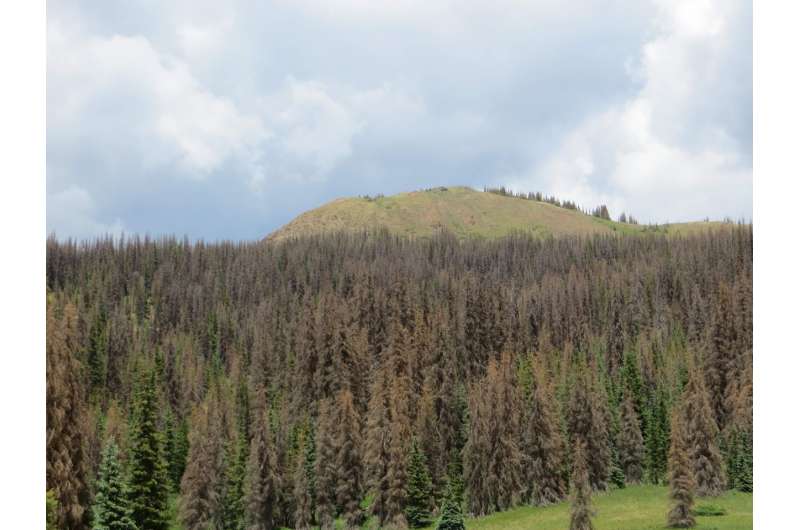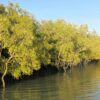Earth’s rapidly changing climate is taking an increasingly heavy toll on landscapes around the world in the form of floods, rising sea levels, extreme weather, drought and wildfire.
Also at growing risk are the values of property where these hazards are projected to worsen, according to a new study by University of Utah scholars.
The research team, led by biology professor William Anderegg, attempted, for the first time, to quantify the value of U.S. property at risk in forested areas exposed to increased wildfire and tree mortality associated with climate stresses and beetle infestation. Their findings have been published in Environmental Research Letters.
“As a society, we have this tremendous capacity to deal with and minimize, adapt to and mitigate risk,” said Anderegg, who heads the university’s Wilkes Center for Climate Science & Policy. “We have insurance policies, we have seat belts in cars and airbags. All of these are to mitigate the risk of getting in a car accident or having a fire burn down your house. But fundamentally, all these tools to mitigate risk are predicated on knowing what the risks are and capturing how those risks might change.”
A stark message from Maui
Climate change is a “game changer,” according to Anderegg, because it promises to elevate threats, yet we don’t know exactly where, when or by how much.
“This is a really clear case of where we need cutting-edge science and tools to tell us what are the risks and how are they possibly or likely to change this century due to climate change,” said Anderegg, who studies forest ecology. “Climate change is going to drive wildfire and disturbance risks up and is already driving them up. Insurers leaving states like California really underscores that.”
To help identify climate-related risks to property values, Anderegg teamed with faculty from the College of Social and Behavioral Sciences—geographer Tim Collins and sociologist Sara Grineski—and others outside Utah. Their study found more and more U.S. property will be exposed as climate change effects proliferate on forests.
“We find that property values exposed to these climate-sensitive disturbances increase sharply in future climate scenarios, particularly in existing high-risk regions of the western U.S.,” the study determined, “and that novel exposure risks emerge in some currently lower-risk regions, such as the southeast and Great Lakes regions.”
And as if to drive that point home, the tropical Hawaiian Islands were the scene of the nation’s deadliest wildfire in a century after flames rampaged across Maui, destroying an entire city and leaving 96 dead in a toll that will certainly grow.
Most of the affected real estate is in the Southwest and California, where soaring values of private property near publicly owned woodlands are colliding with declining forest health and escalating fire risks.
The study deliberately avoided identifying specific areas at risk, but even a casual glance at Western real estate gives an idea of where the trouble spots are. Northern Utah’s more valuable residential property happens to be located in scenic locales, such as Emigration Canyon and Summit Park, that face severe wildfire risks.
The study examined three different phenomena that impact property values: wildfire; tree mortality from drought and other climate stresses; and tree mortality from insect infestation.

A stand of conifers killed by bark beetles in southwest Colorado. © William Anderegg, University of Utah
Tale of two climate crisis responses
The study projected what may happen during two 30-year windows, mid-21st century and end of the century, under opposing scenarios. The team found carbon emission-reduction strategies, if implemented effectively, could substantially dampen exposure.
“We looked at two separate climate scenarios, one in which we don’t really do anything [to reduce emissions driving warming]—it’s just business as usual, and things get more dramatically worse—and one in which we implement mitigation more aggressively,” said Collins, who co-directs the University of Utah’s Center for Natural and Technological Hazards with Grineski.
“What the results show is that under a scenario in which we actually try to mitigate emissions in a way that reduces impacts of climate change, you see substantially less property value at risk in the future.”
Looking at just privately owned lots one acre in size or larger, about $4 billion (in 2017 dollars) in property is currently exposed per year to wildfire in the contiguous United States, according to the study.
That volume is projected to grow to $22 and $45 billion, by 2049 and 2099, respectively, under the do-nothing scenario. The study found, however, the value of exposed property tops out at about $11 billion under the scenario in which aggressive climate action is undertaken.
Wooded areas can be desirable places to live, but if the trees die or burn, such properties lose their appeal and their market value will erode accordingly.
“What’s interesting is that people are drawn to those environments because of the amenities associated with forest resources,” Collins said. “This is where you’re seeing the high value of these lands, like California—areas that are identified as wildland-urban interface—are some of the fastest growing landscapes in terms of residential development.”
The findings are conservative since they don’t consider anticipated growth in these at-risk landscapes.
“Under climate change, in the hot arid West, many people, as temperatures rise, are going to be increasingly drawn to these mountainous environments,” Collins said.
“We actually just hold constant current levels of development, and we look at what is the effect of climate change and increased forest disturbance in terms of placing current property values at risk in the future. It doesn’t even take into account the fact that more and more people are being drawn to these forest landscapes because of the amenities.”
Collaborators on the project included Christophe Nolte of Boston University and Sarah Nicholls of Swansea University in Wales.
More information:
Climate change greatly escalates forest disturbance risks to US property values, Environmental Research Letters (2023). DOI: 10.1088/1748-9326/ace639
Provided by
University of Utah
Citation:
Without climate action, property values will take a hit from escalating wildfire risk and tree mortality, study finds (2023, August 17)



